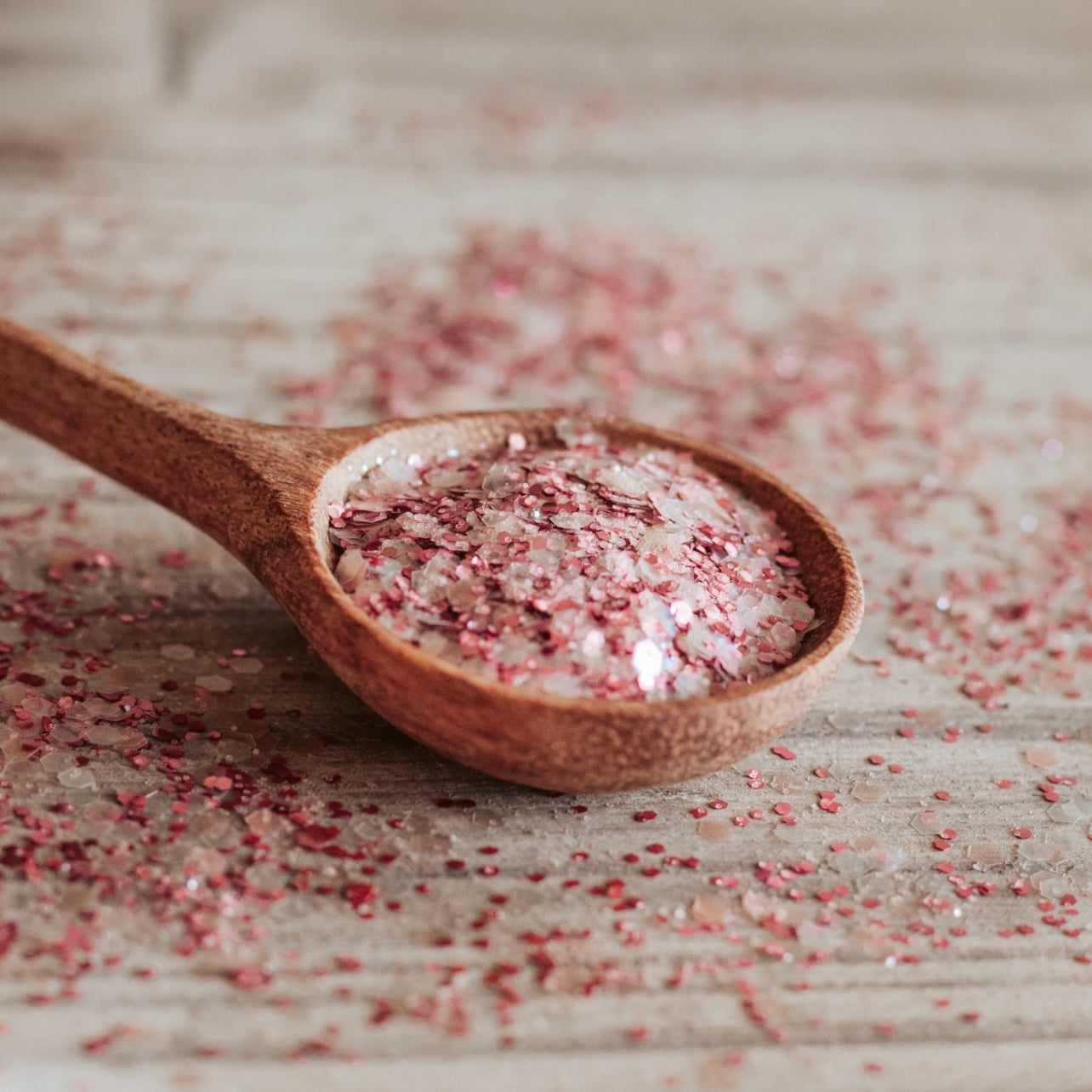
Biodegradable eco friendly glitter - The facts today
Listen up, sparkle lovers because I'm about to spill some sassy truth tea. Brace yourselves,
'cause the compostable glitter game has some dirty secrets.
You wanna know a fun fact?
If your glitter isn't hexagonal, Mother Earth won't give it the time of day. Yeah, you heard me right. Those heart and star-shaped glitters may be all cute and sparkly, but they're gonna leave a trace behind,.
No doubt about it.
These fancy smancy shaped glitters are made from PLA
IT'S A FACT ......... if your glitter is not hexagonal Mother Nature can not break it down.
Here's the deal: compostable glitter ain't all it's cracked up to be. Sad, but true. You see, some so-called "compostable" glitters are made from PET plastic or PLA Polylactic Acid. And let me tell you, honey, that stuff won't break down in a natural environment.
PLA ( Polylactic Acid) we hate this stuff!
It's thermoplastic polyester bio-polymer. It's made from genetically modified corn, y'all. Sure, it sounds eco-friendly, but let me burst that bubble for you. Bio-plastics like PLA won't biodegrade in the natural environment. Nope, they need the controlled conditions of industrial composting processes to even stand a chance.
YET THEY STILL CALL IT "COMPOSTABLE"
The sad truth is, glitter is more likely to end up in our waste, our waterways, and the great outdoors after we're done with it. Recycling compost bin? Yeah, not gonna cut it.
Glitter's small size and how we use it make that whole solution highly unlikely, darlings.
Now, let's talk about these glitter manufacturers and their claims.
They'll go on and on about how their compostable glitter will degrade, many actually call it "eco glitter" but here's the kicker: that can only happen in an industrial composter. Not in the great outdoors, my friend. So, here's a friendly reminder: check if your glitter is certified home compostable, even if they claim it's plant-based eco glitter!
SO INCASE WE DID'NT MAKE IT CLEAR ENOUGH ..........
PLA WILL NOT biodegrade in the natural environment, they need the man-made conditions (elevated temperatures and extremely high humidity) found in industrial composting processes.
It's oh so misleading I hear ya.
They can call it plant based and compostable glitter.
If you're thirsty for more knowledge, the internet's got plenty of documented info that exposes PLA's inability to biodegrade in nature. Trust me, it's a disappointing reality.
Check out this UN report it offers some eye opening insights.
So, how can you spot the real deal when it comes to biodegradable glitter? Well, my friend, you'll have to do your research. Don't fall for glitter claiming to be "eco-friendly" or "biodegradable" without the receipts. Look for that certified home compostable creds, 'cause that's where the truth lies.
So how can you spot the difference between actual biodegradable glitter and glitter claiming to be biodegradable or "ECO FRIENDLY" once you have it already sitting on your bench.
TEST IT TEST IT TEST IT
Try this it's a VERY BASIC SCREENING TEST to determine if your glitter is microplastic or MAINLY BASED on PLASTIC, such as PET, PVC, PLA or Cellulose Acetate (not biodegradable in natural environments, IE Microplastic).
If the glitter melts it is mainly based on plastic and is a microplastic. However, this test CANNOT BE USED TO DETERMINE IF a product is 100% PLASTIC FREE or NOT MICROPLASTIC.
To prove a glitter is NOT A Microplastic requires more complex evaluation involving passing environmental biodegradability standards such as ISO14851 Fresh Water Biodegradation, the level of testing we subject our Bioglitter products to. The ‘ECHA Mircroplastic Proposal, Jan 2019’ defines what constitutes a product is a microplastic or not.
Method for basic heating or burning test:-
Heat or burn the glitter product. If it melts and sticks to the surface it’s on, the glitter mainly contains plastic. We find it's easiest to put the glitter on a sheet of aluminium foil and heat with a naked flame from beneath.


Always ask your supplier to provide scientific proof of biodegradability in the natural environment and that a product is not made from plastic. Don’t be mislead by basic composting biodegradation testing, this is NOT proof that a product will biodegrade in the natural environment. PLA and Cellulose Acetate compost, but, do not biodegrade in the natural environment. Therefore, if PLA or Cellulose are used to make a glitter, the glitter will be a micro-plastic and environmental pollutant.
Glitter companies selling 'compostable glitter' made from corn Polylactic Acid (PLA) say don't worry your local wastewater treatment plant will break it down. THIS IS MISSLEADING
Please don't assume your glitter will be treated at a wastewater treatment facility. In Australia our storm water drains lead right into our waterways so if it falls off outdoors this is where it will end up.
FOR BIODEGRADABLE GLITTER THAT BREAKS DOWN IN NATURE
THAT WILL NOT HARM MARINE LIFE IF DIGESTED
GUARANTEED BIODEGRADATION IN A NATURAL ENVIRONMENT
GET YOUR ECO FRIENDLY GLITTER FROM THE GLITTER TRIBE
HAVE MORE QUESTIONS ABOUT GUILT FREE GLITTER?

Comments
Dani said:
My daughter and I love your glitter.
We use it for play dough.
Thankyou for making this glittery goodness.
Love D xx
EMILY WOLF said:
WOW!!
I did the burning test.
It stunk and was so smokey.
So this means the holographic bio glitter from
Amerikan Body Art is not truely biodegradable is that right?
It just melted and did not turn to ash.
I feel sad.